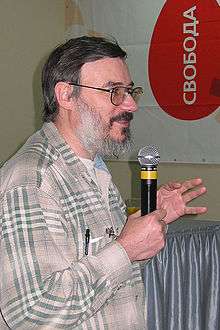Kirill Eskov

Kirill Yuryevich Eskov (Russian: Кирилл Юрьевич Еськов) (born. September 16, 1956 in Moscow, Soviet Union) is a Russian writer, biologist and paleontologist.
Eskov graduated from the Department of Biology of Moscow State University in 1979. In 1986 he defended a dissertation for the Candidate of Biological Sciences at the A.N. Severtsov Institute of Animal Evolutionary Morphology and Ecology of the USSR Academy of Sciences, the theme being "Spiders of Northern Siberia (horology analysis)".[1] His main scientific interests as a biologist are the spiders of Siberia and the Russian Far East and, as a paleontologist, the Paleozoic and Cenozoic eras. As of 2008 he is the Senior Researcher at the Laboratory of Arthropods of the Paleontological Institute of Russian Academy of Sciences and vice-president of the Eurasian Arachnological Society. He has worked at the institute since 1988. As of 2002 he had 86 scientific publications.
Eskov discovered several new genera of spiders. Among seven discovered by him in 1988 is Kikimora palustris Eskov, 1988[2] It belongs to the Linyphiidae family, is found in Russia and Finland, and the name translates from Latin as "marsh Kikimora". Kikimora is a female spirit in Slavic mythology and the Russian equivalent of the phrase, "кикимора болотная", is well known in Russian common language.
He is also the author of the book "History of the Earth and its lifeforms", intended as a cutting edge biology textbook for high schools.
As a fiction writer he published several books, one of the most famous being The Last Ringbearer (Russian: Последний кольценосец), an alternative retelling of J. R. R. Tolkien's The Lord of the Rings, as told from the point of view of Sauron's forces, based on the proverb: "History is written by the victors."[3] The book was "published to acclaim in his homeland in 1999. Translations of the book have also appeared in other European nations, but fear of the vigilant and litigious Tolkien estate has heretofore prevented its publication in English."[3] In late 2010, however, an English translation approved by Eskov was posted on LiveJournal,[3] and made available under non-commercial license.[4] Critics have called The Last Ringbearer "a well-written, energetic adventure yarn that offers an intriguing gloss on what some critics have described as the overly simplistic morality of Tolkien's masterpiece."[3]
Among his other books is The Gospel of Afranius (Russian: Евангелие от Афрания), a dramatic portrayal of Jesus. In the novel he attempts to construct a demythologised account of the events of the Gospels.
Selected scientific publications
- Eskov, K.Y. (1988). "Seven new monotypic genera of spiders of the family Linyphiidae (Aranei) from Siberia". Zool. Zh. 67 (5): 678–690.
- Eskov, K.Y. (1993). "Several new linyphiid spider genera (Araneida, Linyphiidae) from the Russian Far East". Arthropoda Selecta. 2 (3): 43–60.
Footnotes
- ↑ Biography at IKIP Archived 2007-04-26 at the Wayback Machine.
- ↑ World Spider Catalog - Linyphiidae
- 1 2 3 4 Miller, Laura (2011-02-15) , Salon.com
- ↑ The Last Ring-bearer
External links
- The Back Story to the Last Ring-bearer, by Dr. Kirill Eskov
- Translator's blog
- (in Russian) Kirill Eskov's blog
- (in Russian) Short biography at the Paleontological Institute
- (in Russian) List of publications on his personal page at the Laboratory
- (in Russian) Critique
- (in Russian) His books in the Lib.ru.